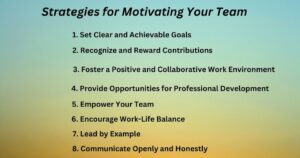Are you struggling to motivate your team? As a leader, one of your most important responsibilities is to keep your team motivated. A motivated team not only achieves great results but also sparks creativity, improves collaboration, and ensures long-term success. When your team feels engaged and energized, their productivity soars, turning the workplace into a dynamic hub of innovation.
In this article, we will explore how to motivate team members as a leader using effective strategies, helpful statistics, and inspiring quotes. Whether you want to inspire individual team members or boost overall morale, you will find practical insights here to help you lead successfully.
Why Motivation Matters in Leadership
Motivation is the foundation for achieving high performance in any team. As a leader, your ability to motivate your team can significantly impact the overall success of the organization.
According to Gallup, highly engaged teams are 21% more productive than their disengaged counterparts, which highlights just how much motivation can drive business outcomes.
Additionally, motivated employees are 23% more profitable and tend to stay with the company longer, reducing turnover costs and maintaining continuity.
- Key Takeaway: Understanding how to motivate team members as a leader is not just about performance, it drives creativity, engagement, and long-term success.
Strategies for Motivating Your Team
To build a motivated team, it’s important to use different strategies that focus on various aspects of motivation. Here are some simple and practical ways to boost engagement and create a positive, productive team environment:
 |
| How to Motivate Team Members as a Leader: Top Tips |
One of the most effective ways to motivate your team is by setting clear, challenging goals that align with both organizational objectives and personal aspirations.
Locke and Latham’s Goal Setting Theory emphasizes that specific and challenging goals lead to higher performance. Use the SMART goal framework—Specific, Measurable, Achievable, Relevant, and Time-bound—to ensure everyone on your team has a clear direction.
Example: Instead of simply telling your team to “increase sales,” set a specific target like, “Increase sales by 15% in the next quarter.” This clarity helps team members focus on the end goal and increases their drive to meet targets.
Tips:
- Break Down Goals: Divide larger objectives into smaller, manageable tasks to prevent overwhelm and allow for quick wins.
- Regular Check-Ins: Schedule regular progress meetings to discuss milestones and adjust goals as necessary.
Statistics:
According to a report by Harvard Business Review, teams with clear goals are 22% more productive than those without a defined purpose.
2. Recognize and Reward Contributions
Employee recognition is one of the most powerful ways to motivate team members. When team members feel appreciated, they are more likely to stay engaged and go the extra mile.
Research by OC Tanner shows that 79% of employees who quit their jobs cite “lack of appreciation” as a primary reason for leaving.
Recognition doesn’t always need to be financial. A heartfelt thank-you, public acknowledgment, or even a small personalized reward can significantly boost morale and motivation.
Example: Implement a recognition program that highlights both individual and team achievements. Celebrate small victories like meeting a project deadline or reaching a sales milestone to create a culture of appreciation.
Tips:
- Use Peer Recognition: Encourage team members to recognize each other’s efforts through a “shout-out” board or a dedicated channel in team communication tools.
- Tailor Rewards: Understand what motivates each team member and personalize rewards to match their preferences, whether a day off, a gift card, or extra professional development opportunities.
Quote: “You don’t have to be great to start, but you have to start to be great.” — Zig Ziglar
3. Foster a Positive and Collaborative Work Environment
Teamwork and collaboration are central to motivation. A supportive environment encourages open communication, idea-sharing, and creative problem-solving.
Maya Angelou once said, “People will forget what you said, people will forget what you did, but people will never forget how you made them feel.” When your team feels supported and valued, they’re more likely to stay motivated and contribute to the team’s success.
Motivating your team requires understanding their emotions and needs. Emotional intelligence in leadership plays a key role in building strong connections and fostering a positive atmosphere.
Statistics: Companies with strong communication practices are 25% more productive than those that lack effective communication. Encouraging open dialogues, whether through team meetings, feedback sessions, or casual conversations, fosters trust and drives team cohesion.
Example: Use communication tools like Slack, Microsoft Teams, or Trello to enhance collaboration and keep everyone connected. Regular brainstorming sessions can also inspire fresh ideas and foster a sense of belonging.
Tips:
- Create Safe Spaces: Establish an environment where team members can express ideas and concerns without fear of judgment.
- Engage in Team-Building Activities: Organize regular team-building exercises, both virtual and in-person, to strengthen relationships and collaboration.
4. Provide Opportunities for Professional Development
Investing in your team’s professional growth is not only an excellent way to motivate team members but also demonstrates that you value them.
According to a LinkedIn report, 94% of employees said they would stay longer at a company that invested in their professional development. Offering opportunities for training, mentorship, and career advancement helps team members feel valued and equipped to succeed.
Example: Implement a “Learning Friday” initiative where employees can dedicate time each week to upskill. Offering online courses, workshops, or sponsoring certifications shows that you are committed to their growth.
Tips:
- Encourage Goal Setting: Have team members set their own professional development goals and discuss them during performance reviews.
- Mentorship Programs: Pair less experienced team members with mentors in the organization to foster growth and knowledge sharing.
Key Takeaway: A commitment to development enhances motivation by showing team members that their future within the company is important.
Empowerment is a critical factor in motivation. When team members have the autonomy to make decisions and contribute their ideas, it fosters a sense of ownership and accountability. Empowering your team to take control of their tasks encourages creativity and increases their investment in the work.
Even introvert leadership qualities, like active listening and thoughtful decision-making, can be incredibly effective in team motivation. Learn how quiet leaders excel.
Quote: “Leadership is not about being in charge. It’s about taking care of those in your charge.” — Simon Sinek.
Example: Instead of micromanaging, assign tasks with clear expectations and allow your team members to determine how they will achieve them. This autonomy helps them feel trusted and motivated to excel.
Tips:
- Encourage Innovation: Create a platform where team members can propose new ideas and solutions without barriers.
- Support Decision-Making: Provide resources and information that enable team members to make informed decisions independently.
Statistics: A McKinsey study found that 72% of employees said that autonomy in their roles positively affected their job satisfaction and performance.
6. Encourage Work-Life Balance
Supporting work-life balance is essential for maintaining long-term motivation. When employees feel overwhelmed and burnt out, their productivity and engagement drop significantly.
According to a Gallup survey, employees who have a good work-life balance are 21% more productive and are more likely to stay with the company.
Example: Offer flexible working hours or remote work options, especially when personal commitments require attention. Additionally, encourage your team to take breaks and disconnect from work to avoid burnout.
Tips:
- Promote Time Off: Encourage employees to take their vacation days and use personal time to recharge.
- Wellness Initiatives: Implement wellness programs that support mental and physical health, such as yoga classes or mindfulness sessions.
Quote: “Balance is not something you find; it’s something you create.” — Janna King
7. Lead by Example
As a leader, your attitude and work ethic set the tone for your entire team. Demonstrating enthusiasm, resilience, and commitment to the team’s success can inspire others to adopt a similar mindset. Your actions should align with the values and culture you want to foster within your team.
Example: If your team is working late to meet a deadline, be there alongside them, showing solidarity and dedication. Your actions communicate that you are willing to put in the effort, and your team will be motivated to follow your lead.
Tips:
- Share Your Challenges: Be open about your own challenges and how you overcome them, showing vulnerability and relatability.
- Celebrate Together: When the team achieves a goal, celebrate collectively to reinforce the idea that everyone’s contribution matters.
Quote: “The key to successful leadership is influence, not authority.” — Kenneth Blanchard
8. Communicate Openly and Honestly
Transparency is essential for building trust and fostering a positive work environment. Regularly check in with your team to discuss progress, challenges, and any concerns they may have. This openness not only keeps everyone aligned but also makes team members feel heard and valued.
Example: Hold weekly one-on-one meetings with team members to address individual goals, provide feedback, and discuss any challenges. This shows that you care about their personal growth and well-being.
Tips:
- Use Feedback Tools: Implement anonymous feedback tools to gather insights and suggestions from team members.
- Be Approachable: Make it clear that you are available for discussions, encouraging team members to come to you with any issues.
Key Takeaway: Open communication fosters trust and motivates team members to work toward shared goals.
 |
| How to Motivate Team Members as a Leader: Top Tips |
Conclusion:
Motivating your team as a leader is not a one-time task—it’s a continuous effort that requires understanding, care, and consistency. By setting clear goals, appreciating their hard work, encouraging teamwork, offering chances to grow, and giving them the freedom to make decisions, you can build a happy, motivated, and productive team.
Good leadership isn’t just about using strategies—it’s about truly knowing your team, listening to their needs, and making sure they feel valued and supported.
Key Takeaways:
- Set clear goals that are realistic and aligned with your team’s and company’s objectives.
- Appreciate and reward their efforts to keep them motivated and happy.
- Create a positive environment where teamwork and open communication are encouraged.
- Help them grow by providing learning opportunities and showing you care about their future.
- Give them responsibility so they feel trusted and empowered.
- Lead by example to inspire them through your own actions and attitude.
When you focus on these steps, you will not only help your team perform better but also create a workplace where people enjoy what they do and work together to achieve success.
As Steve Jobs said, “The only way to do great work is to love what you do.” When your team is motivated, they will not just love their work—they will thrive at it.
FAQs
1. How can I effectively motivate my team?
To effectively motivate your team, focus on:
- Setting clear and achievable goals.
- Recognizing and rewarding their contributions.
- Creating a positive work environment.
- Encouraging open communication.
- Offering opportunities for professional development tailored to individual needs.
2. What are some quick motivational tips for team leaders?
Quick motivational tips for team leaders include:
- Providing regular feedback.
Celebrating small wins. - Encouraging collaboration among team members.
- Offering flexible work arrangements.
- Creating a culture of appreciation through simple gestures like thank-you notes.
3. Why is employee recognition important for motivation?
Employee recognition is crucial because it:
- Makes team members feel valued and appreciated.
- Increases engagement and productivity.
- Motivates employees to be more committed to their work, leading to better performance.
4. What strategies can I use to boost team morale?
To boost team morale, consider:
- Implementing team-building activities.
- Providing opportunities for professional growth.
- Encouraging social interactions among team members.
- Recognizing individual and team achievements.
- Maintaining a positive and inclusive work culture with regular check-ins.
5. How do I identify what motivates my team members?
You can identify what motivates your team members by:
- Conducting surveys to gather insights.
- Having one-on-one conversations to understand their preferences.
- Observing their behaviors and interactions.
- Asking about their career aspirations and what they value most in their work environment.




